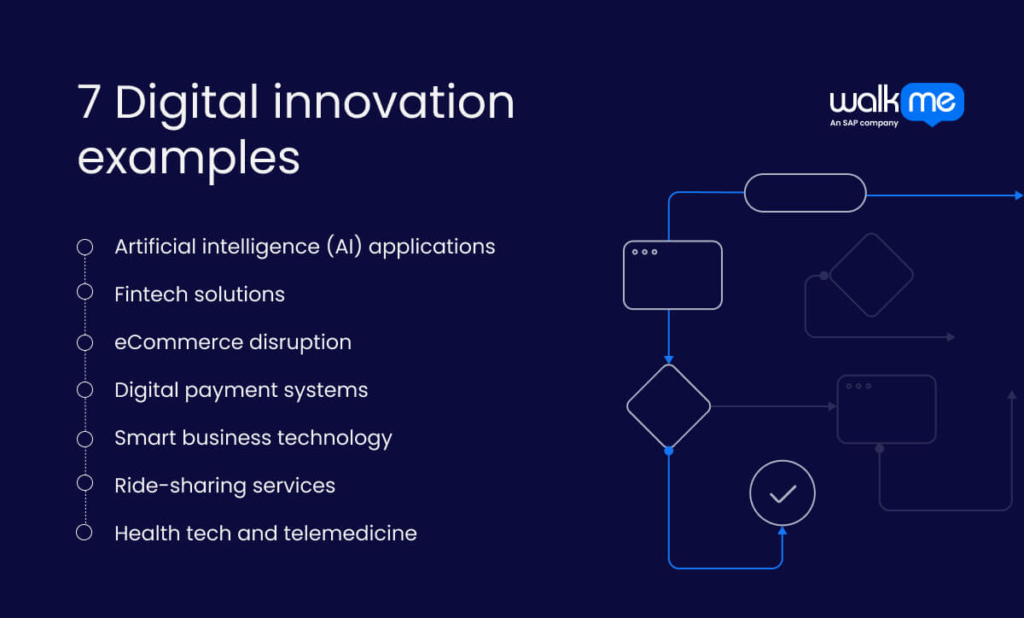According to McKinsey, enterprises are rapidly adopting digital technologies, including cloud computing, advanced connectivity, and applied AI.
These are all examples of digital innovation reshaping enterprise priorities and helping businesses prepare for the future by embracing new and emerging tech.
Digital innovation is one of the most important priorities for businesses. A recent Deloitte report shows that 79% of CEOs consider digital transformation among their top three strategic prerogatives for the next three years. This shows the importance of digital innovation in shaping business strategies and helping companies stay competitive.

With that in mind, this article will explore seven examples of digital innovation and provide specific business instances to help illustrate how these technologies are transforming industries.

- Artificial intelligence (AI) applications
Artificial intelligence (AI) applications are changing how businesses use technology and approach digital innovation. AI does more than automate tasks and is becoming a key tool for making decisions that shape business strategies.
Businesses can quickly analyze large amounts of data with AI, find patterns, and predict customer needs. This gives companies an edge in staying ahead of market trends.
With AI, businesses can create personalized customer experiences, offering services that feel more tailored to them. As business needs change, it helps improve products and customer interactions. The message is clear. Companies that don’t use AI risk falling behind.
A recent Deloitte report shows that 62% of business leaders believe AI is essential for long-term success. This reflects a broader industry trend that AI isn’t just a tech upgrade but a core business function driving prospective success.
Business example: OpenAI (ChatGPT, DALL-E)
ChatGPT is an example of digital innovation, particularly in AI-driven educational technology.
It can answer questions, assist with writing, and even help students learn new subjects. Analyzing vast amounts of information provides quick, relevant responses, making it a helpful tool in education and beyond.
Educational technology is already growing in UK schools and is expected to increase in the coming years, especially with the fast development of AI. The AI element of ChatGPT is a key part of how this technology is evolving. It offers new ways for students, teachers, and professionals to access information and improve productivity.
- Fintech solutions
Through innovative software, fintech is transforming financial services, making them more efficient, secure, and user-friendly.
Examples include online banking, digital wallets, peer-to-peer lending, and blockchain. With AI, fintech can offer tailored financial advice, spot fraud, and speed up transactions. Digital payment systems simplify shopping and sending money worldwide, while AI agents help people invest without needing a human advisor.
Fintech also removes barriers, making financial services more affordable and accessible. As these technologies keep developing, their impact on how we handle money will grow, making financial services more convenient and efficient for everyone.
According to a recent Gartner survey, 58% of finance functions utilize artificial intelligence (AI) technologies, marking a 21 percentage point increase from the previous year.
Business example: Robinhood (commission-free stock trading)
Robinhood revolutionized stock trading by offering commission-free services, making it easier for young people to trade through an app. Its digital innovation disrupted the traditional brokerage industry, creating a more accessible investment method.
However, in 2025, the company faced a $45 million fine for not properly explaining how it made money by selling users’ trades. This highlights the need for clear regulations in fast-growing sectors like fintech to protect consumers while encouraging innovation.
- eCommerce disruption
Businesses are rethinking sales strategies as eCommerce revolutionizes the market, using technology to improve customer experiences.
Companies are making shopping easier for consumers with AI-driven predictions, personalized ads, and streamlined logistics. Social commerce is also growing, where influencers sell products directly on platforms like Instagram.
Yet, as eCommerce expands, businesses must follow proper data security practices and meet regulations. Digital innovation is pushing eCommerce forward, but adaptability is key to staying competitive and avoiding legal issues while meeting the needs of modern shoppers.
According to a 2024 Boston Consulting Group report, eCommerce will account for 41% of global retail sales by 2027. This surge highlights how crucial digital innovation is for businesses hoping to take advantage of emerging technologies to boost sales and customer satisfaction.
Business example: Amazon (personalized shopping, logistics innovation)
Amazon has transformed the way we shop and use technology. With perks like quick delivery and streaming content, Amazon Prime made online shopping faster and easier. While AWS changed how businesses operate by providing tools to store and manage data.
These ideas show how Amazon focuses on improving customers’ lives through innovation. Constantly improving and focusing on customer needs, Amazon has established itself as a global leader in digital technology.
- Digital payment systems
With digital payment systems, transactions are becoming faster and more seamless, transforming how we make purchases. Services like PayPal, Apple Pay, and Google Pay let people shop, transfer money, and pay bills from their phones or computers.
These systems use technology to make payments safer and easier, eliminating the need for physical cards or cash. Features like fingerprint and face recognition make payments faster and more secure.
This shift is helping businesses grow and creating new opportunities for consumers to purchase in various ways while keeping up with the digital world.
The total value of digital payments worldwide is projected to reach $11.55 trillion in 2024, highlighting the rapid growth and adoption of digital payment systems.
Business example: PayPal (global online payment system)
PayPal continues to push the boundaries of digital innovation with product updates aimed at transforming online commerce. They’ve introduced password-free logins and a Fastlane checkout option, making it quicker for customers to complete their purchases.
AI is used to understand customers’ wants, helping stores create a more personalized shopping experience. These AI tools make checkout safer and smarter by predicting what people like. PayPal is constantly improving, offering better experiences for customers and easier options for businesses to grow.
- Smart business technology
Smart business technology started with ideas from smart homes and is changing how businesses perform daily operations. What started with devices like smart thermostats and security cameras for homes has grown into tools that help companies run intelligently.
Companies use smart tech to manage energy, watch over security, and even automate tasks in different areas. For example, smart lighting can adjust based on the number of people in the office, while AI systems can predict what products need restocking.
This technology makes businesses more efficient and helps them improve customer service and productivity. As automation technology is adopted, they can save money and offer more sustainable solutions. The key is using these technologies wisely, while keeping business goals and security in mind.
Smart home technologies like smart thermostats, security cameras, and voice assistants are increasingly used in business operations. A recent report by Research and Markets predicts the global smart home market will grow to $74.8 billion by 2028. This reflects how businesses are expanding into this industry and using these technologies as part of their digital transformation strategies.
Business example: Google Nest (smart thermostats, business automation)
Google is making business technology smarter by using automation and AI to improve how they work. They’re taking ideas from smart home tech, like the Google Home Hub, and applying them to offices and businesses.
These systems can automatically adjust things like lighting and temperature based on employees’ needs, making work easier and more productive. Google’s technology also uses data to help businesses make better decisions and offer better services to customers.
- Ride-sharing services
Uber and Lyft are redefining transportation, offering new, more flexible travel methods. These businesses use technology to connect drivers with passengers quickly through an app.
For businesses that run these services, it means new ways of doing things, like offering carpooling or subscription rides for customers. These companies use smart technology to understand when people need rides and where to send drivers, ensuring rides are fast and efficient.
With real-time data, they can adjust prices and routes to save time and money. Innovation in ride-sharing is all about using technology to give customers quicker and more reliable rides while helping businesses stay competitive and keep improving their services.
The global ride-sharing market is projected to reach $120.84 billion in 2024, reflecting a significant rise in demand driven by urbanization and the adoption of digital platforms. This growth shows how businesses in the ride-sharing industry are tapping into digital tools to expand their services and meet the needs of modern consumers.
Business example: Uber (data-driven route optimization)
Uber has completely changed ride-sharing with its smart digital technology. The Uber app connects drivers and passengers in real-time, so you can get a ride whenever you need one without waiting. The app uses GPS to find the quickest routes and adjusts prices based on how many people use the service.
Passengers can rate their drivers, which helps improve safety and reliability. This feedback system ensures a higher service standard and allows drivers and riders to make informed decisions. Uber has made getting around easier and more convenient for everyone, setting the standard for how ride-sharing works today.
- Health tech and telemedicine
Telemedicine and health tech are revolutionizing healthcare, improving patient access and quality. Telemedicine allows patients to talk to doctors through video calls or messages, so they don’t have to go to a clinic.
This is especially helpful for people in areas far from medical centers. Wearable devices, like smartwatches, track health stats such as heart rate and steps, which doctors can use to monitor your health.
Telemedicine and health tech make it easier to detect health issues and better manage chronic conditions. Digital tools make healthcare more convenient, providing easier access and better tracking. Doctors can monitor patients’ health remotely, improving care without requiring in-person visits.
It’s no surprise that telemedicine has experienced significant growth in recent years, with projections indicating continued expansion. A report from McKinsey forecasts that the health tech market will reach $250.8 billion by 2024. The rapid adoption of digital health technologies largely drives this.
Business example: Teladoc Health (virtual healthcare services)
Teladoc Health is a global company that provides virtual healthcare, allowing people to see doctors online. After growing quickly, the company needed to combine different systems used in various countries.
They achieved this by uniting multiple systems into a single, efficient platform, which helped improve the company’s efficiency and patient care. With this new system, tasks like processing invoices have become faster, and Teladoc can provide better care for people worldwide.
Reflecting on your digital innovation
Digital innovation is changing how businesses work, compete, and serve customers. From AI making services more personal to telemedicine improving healthcare access, companies are using technology to solve problems and create new opportunities.
These changes go beyond efficiency, opening doors to new ideas and opportunities for growth. Businesses are finding new ways to earn, keep customers happy, and adapt to a world thats fast changing.
But this is just the beginning. Companies that embrace digital technology now will stay ahead as new innovations continue to emerge. Success comes from using these tools wisely, helping businesses grow and thrive in the long run.
FAQs
Digital innovation means making new or better technology. Digital transformation is when businesses use that technology to improve how they work. Innovation creates tools, like apps or systems, while transformation uses them to make things faster, easier, or more efficient for the business and its customers.
A digital innovation strategy is a plan for using new technology to improve a business. It helps companies find better ways to work, solve problems, and grow. The goal is to stay competitive using tools like apps, AI, or online systems that make things faster or easier.
A digital innovation strategy helps businesses improve their operations by using new technology. It speeds up work, saves money, and helps businesses grow. With this plan, companies can stay ahead of competitors, solve problems better, and keep customers happy using the latest tools and ideas.
![7 Digital innovation examples [2025]](https://www.walkme.com/blog/wp-content/uploads/sites/2/2025/02/7-_Digital-Innovation-Examples_4767a99d-725x460.webp)
